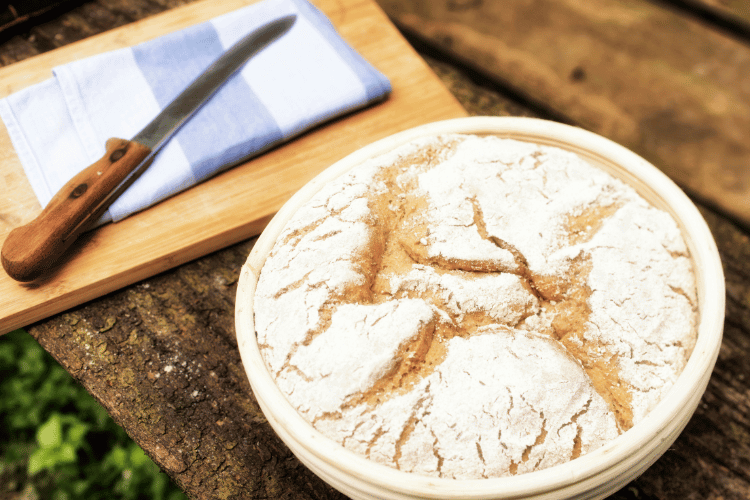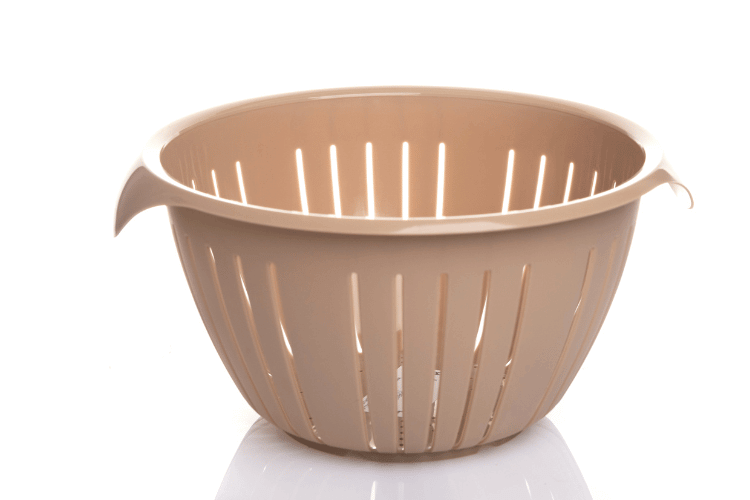Picture this: you’re standing in the kitchen, ready to bake a crusty homemade bread, only to find out you don’t have one of the crucial tools—the banneton.
Don’t fret about it, though. We’ll unveil seven banneton substitutes that help you proceed with your bread-making journey. From regular bowls to kitchen towels, keep reading for all the details!

What Is the Use of a Banneton?
Before we jump to the different banneton substitutes, let’s first discuss why this kitchen utensil is essential.
For those who don’t know, a banneton, or a proofing basket, is a handy baking tool. It’s commonly used for making sourdough bread or other yeast-based products.
As you might know, after kneading dough, you need to let it rest for a while so that the yeast works its magic, and then throw the bread in the oven.
Such a process is known as proofing. The yeast breaks down sugar molecules, releasing carbon dioxide gas. Consequently, it helps the dough rise, producing air-pocket-loaded bread.
A banneton basket helps in that process. It provides structure, helping the dough rise instead of spreading.
The basket’s design allows proper airflow. That draws excess moisture out of the dough, helping it hold its shape once baked. Not to mention, it can add a nice pattern to the bread’s surface!
Those bread-proofing baskets come in many materials. Some of the common types include:
- Plastic banneton
- Wood pulp banneton
- Rattan banneton
- Cotton banneton
What Is the Best Size for Bread-Proofing Containers?
Size is one of the most essential factors when choosing a proofing basket. If the dimensions are too big, the bread dough will spread. As a result, you’ll end up with flatbread.
On the other hand, a small container will restrain the dough’s movement, causing the gas to escape.
To avoid that dilemma, here’s a weight-size reference to help you select the ideal banneton for your dough:
| Dough Weight | Diameter in Inches |
| 100g | 5 |
| 150-200g | 6 |
| 300-400g | 7 |
| 500-700g | 8 |
| 800-900g | 9 |
| 900-1000g | 10 |
| 1000g-1200g | 11 |
| 1200-1500g | 12 |
7 Proofing Basket Alternatives
Here are seven proofing basket alternatives that are as good as a banneton basket:
1. Regular Bowls and Kitchen Towels
A good old regular bowl is probably the simplest alternative to bannetons. That’s because they’re a staple in any kitchen! The best part is that you can use any material; whether it’s a plastic or a metal bowl, both would get the job done.
Even a ceramic bowl used for soup serving would suffice. Regardless of your choice, you need to line the container with a breathable kitchen towel.
Unlike bannetons, a regular bowl doesn’t allow airflow. So all the additional moisture in the dough will stick to the container.
Simply sprinkle a tablespoon of all-purpose flour on the towels. Shake the former to cover the entire surface and remove any excesses. Place the dough on top of the towel and let it rise.
2. Plastic Colander

As surprising as it may sound, you can use a plastic colander for the bread-proofing process. Think about it; the container has numerous tiny holes, providing adequate air circulation.
However, too much air can harden the crust, preventing the dough from fully rising. For that reason, make sure to proof the bread in a warm, draft-free area, especially when using a strainer.
Like regular bowls, stickiness is also an issue that can occur when using a colander. Additionally, the dough can seep into the draining holes if you let it rest a bit too long.
To tackle both issues, simply flour a breathable tea towel and place it in the colander before transferring the dough.
3. Clean Terracotta Pots

That’s right! Terracotta pots don’t only make for useful plant containers; you can also use them in baking. In fact, ancient civilizations in Asia used the same material for cooking 12,000 years ago!
In case you’re wondering, terracotta pots are made of natural, porous clay. As you might have guessed, those pores help drive away additional moisture. The pot shape also helps the dough rise upward, making it a perfect alternative to a banneton.
The best part is that you don’t need to line the container with a cloth. Simply wash the pot with soapy, warm water and dry it well. Then, dust the pot and drain any excess flour.
That said, steer clear of any glazed pots since such products can contain lead. The latter is a harmful chemical found in paint and can lead to poisoning.
4. Wicker Basket With Cling Wrap
Who says your wicker baskets are only to store items and save space? Those home decorating tools make for an excellent banneton substitute. After all, they’re typically made of natural materials similar to banneton, like rattan.
You can also use a bamboo bowl if you don’t have a wicker basket. Both containers have a similar structure to a proofing basket, providing similar benefits. The problem is that the former can be considerably large.
So make sure to use a small basket to prevent the dough from spreading too much. Additionally, line the former with a heavy cloth and cover the dough with cling wrap to prevent excess air from drying it out.
5. Dutch Oven
A Dutch oven is one of the most practical banneton substitutes. Instead of leaving the dough to rest in one container and then transferring it into another for baking, why not use the latter for both?
Typically, a cast-iron Dutch oven is the go-to option for baking sourdough bread. It traps steam, providing optimal temperatures and moisture conditions. As a result, you bake a moist, fluffy loaf with a crispy brown crust.
To use the Dutch oven for the proofing process, simply grease it and let the dough rise. You can also line the former with parchment paper.
6. Bread Pan
Sourdough typically has an oblong or circular shape. However, that doesn’t mean you can’t get creative with the design. Instead of baking the dough as boules or batards, you can use any bread pan you have.
For instance, a rectangular tray is ideal if you want a loaf of bread. You can use a mini-loaf cake pan and use the petite bread to make mouthwatering leftover sandwiches from your favorite smokers recipes.
All you need to do is dust the pan with flour or use backing paper before transferring the dough.
7. DIY Banneton Using a Floured Cloth
Even if you don’t own any of the above utensils, you can still make your favorite yeast bread. Using a heavy linen cloth, aka a couche, you can make a DIY banneton.
Before jumping into the action, make sure to use thick, clean fabric to hold the shape. Once you’ve got that on hand, here’s what you need to do:
- Pleat the towel to resemble an accordion.
- Using elastic bands, secure both ends well.
- Smooth the center of the towel to make it look like a banneton’s base.
- Place the dough inside the DIY bowl and wrap the excess edges around it.
- Cover the DIY banneton with plastic wrap and let the dough rest.
Wrapping Up
While proofing baskets are a valuable tool for bread-making, several banneton substitutes provide similar results.
You can line regular bowls, plastic colanders, and wicker baskets with kitchen towels to use as a banneton. Likewise, flour a clean terracotta pot and let the bread rest before baking. You can also use Dutch ovens or a bread pan to directly bake the dough without transferring it.
If you don’t have any of the former tools, pleat a kitchen towel to make a DIY banneton. Regardless of your choice, all the alternatives can help you achieve a well-risen, beautifully shaped loaf!
- How To Fill a King Cake With Bavarian Cream - April 15, 2024
- Dealing With Mold on Oyster Mushrooms - April 9, 2024
- What Meat Goes With Pumpkin Ravioli? (Ravishing Ravioli Combos) - March 15, 2024
